
Originally published in The Clarinet 51/2 (March 2024).
Copies of The Clarinet are available for ICA members.
BOOKS
Charlotte Kennedy. Manuel Gómez: “The Best Clarinet Player in the World.” Published by Charlotte Kennedy Domínguez, 2023. $21.61
 The Spanish clarinet school has a rich tradition going back to the 19th century. The most significant players who represent this history and its continuation into the 20th century are Antonio Romero, Miguel Yuste, Julián Menéndez, Carmelo Bernaola, and Vicente Peñarrocha. Manuel Gómez Patudo (1859-1922), the subject of this book, was not less important than the others, but is not in this list because though born in Seville, he emigrated from Spain to England, becoming one of the most distinguished performers in that country in the late 19th century. A clarinet player, composer, and clarinet designer, Manuel Gómez established an incredible reputation in England and was markedly influential on the English clarinet playing tradition of those years. His brother Francisco, who was a very good clarinetist, emigrated from Spain to England with him and had a good amount of success as well.
The Spanish clarinet school has a rich tradition going back to the 19th century. The most significant players who represent this history and its continuation into the 20th century are Antonio Romero, Miguel Yuste, Julián Menéndez, Carmelo Bernaola, and Vicente Peñarrocha. Manuel Gómez Patudo (1859-1922), the subject of this book, was not less important than the others, but is not in this list because though born in Seville, he emigrated from Spain to England, becoming one of the most distinguished performers in that country in the late 19th century. A clarinet player, composer, and clarinet designer, Manuel Gómez established an incredible reputation in England and was markedly influential on the English clarinet playing tradition of those years. His brother Francisco, who was a very good clarinetist, emigrated from Spain to England with him and had a good amount of success as well.
Manuel Gómez graduated from the conservatories of Madrid and Paris and embarked upon a brilliant orchestral career in eminent European orchestras such as the Paris Opera, Covent Garden Opera Orchestra, and Queen’s Hall Orchestra, and he was a founding member of the London Symphony Orchestra. He attracted the attention of the British maker of wind instruments Boosey & Co.; in fact, a new Boehm model was produced following the specifications of Gómez. To cite only a few improvements, this clarinet had an extra key for low E-flat and extra keys on the side of the upper joint. Gómez was known as a virtuoso player with a refined tone and an incredible ability to play any difficult part at first sight, only using one clarinet, transposing as necessary. This new, thick book (341 pages!) written by Charlotte Kennedy, who has roots in the Gómez family, has been published (in both English and Spanish) to commemorate the centenary of Gomez’s death. It is a treasure of information and details about his life, which was rich in musical activities, and about the other members of his family in the musical field.
There are accurate descriptions of concert programs, and lists of concerts of chamber music (he played with R. Mühlfeld as second clarinet in a Mozart Serenade) and orchestral activity with countless orchestras. Included is a long list of early recordings with the London Symphony (available on YouTube) and a few he made as a solo player, such as on Clarinets Classics: the “Caro nome” aria from Rigoletto, and Boisdeffre’s Chanson napolitaine. The Spanish clarinetist and researcher Pedro Rubio (who collaborated with Kennedy for this book) has already written a very interesting two-part article for The Clarinet in 2019/2020 about Manuel Gómez and his Gómez-Boehm system clarinet. Charlotte Kennedy has done a superb job conceiving this wonderful book that brings clarinetists a better understanding of this great clarinet player that many have forgotten.
– Luigi Magistrelli
John Macfarlane. A Clarinet Almanac. Austin Macauley Publishers Ltd., 2023. Paperback: £13.99, Hardcover: £20.99, ePub: £3.50
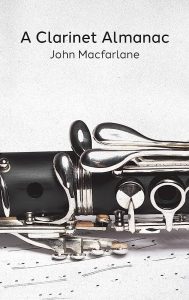 Repertoire lists are common among musicians. In fact, a simple internet search easily populates millions of results. Although each list is different, the basic format of listing works separated into different categories based on criteria such as difficulty, time period, or instrumentation remains the same. What’s more, these lists are often overwhelming with the amount of information they provide. John Macfarlane seeks to break the monotony of the list format and wants to introduce music in an easily digestible format.
Repertoire lists are common among musicians. In fact, a simple internet search easily populates millions of results. Although each list is different, the basic format of listing works separated into different categories based on criteria such as difficulty, time period, or instrumentation remains the same. What’s more, these lists are often overwhelming with the amount of information they provide. John Macfarlane seeks to break the monotony of the list format and wants to introduce music in an easily digestible format.
In A Clarinet Almanac, Macfarlane creates a stylized calendar designed to introduce one work of clarinet repertoire a day to his readers, resembling a daily devotion rather than a laundry list. Each month begins with a calendar page listing the composers and works for that month. Each work is then presented individually with a program note designed to engage readers, spark interest, and encourage looking further into any work that speaks to them. The pieces were taken from Macfarlane’s 65 years in the industry. Selections primarily focus on chamber music, but include solos, operatic works, and large ensemble works spanning some 250 years of music, approximately from 1750-2015. Additional styles including jazz and klezmer make appearances too. To maximize this publication’s accessibility, Macfarlane’s music selections were chosen after confirming that recordings of each piece were easily accessible on YouTube and/or Spotify.
Clarinetists of all skill levels will be able to appreciate A Clarinet Almanac. Naturally there are familiar standards like Hindemith’s Sonata, Brahms’s Clarinet Trio, and Weber’s Grand Duo Concertant, but with 366 works by 245 different composers, I think any clarinetist would be hard-pressed to explore Macfarlane’s work without being introduced to new pieces. If nothing else, it’s a wonderful resource to help everyone map out their daily clarinet literature study in a relaxed way.
– David Deiter
MUSIC
Kristen Denny-Chambers. Finger Fitness Foundations. Clarinet Playground, 2021. Print or Digital: $16.00
_____. Finger Fitness Etudes, Book 3. Clarinet Playground, 2023. Print or Digital: $28.00
 Composed by Dr. Kristen Denny-Chambers, Finger Fitness Foundations are based on the “68 Exercises in Mechanism” from the Klosé Celebrated Method, and can serve as a stepping stone to Finger Fitness Etudes, Books 1 and 2 (reviewed previously). Undoubtedly many of us are familiar with Klosé’s “Mechanisms,” as well as how difficult it can be to get our students of all ages to practice and to value the skills they develop. In writing these etudes, Denny-Chambers has provided us with a creative and fresh avenue to work on these skills with our students. The introductory material provides valuable information about the etudes, including a dedication to one of Denny-Chambers’s own students, and acknowledgements of the many clarinetists that helped her edit the book.
Composed by Dr. Kristen Denny-Chambers, Finger Fitness Foundations are based on the “68 Exercises in Mechanism” from the Klosé Celebrated Method, and can serve as a stepping stone to Finger Fitness Etudes, Books 1 and 2 (reviewed previously). Undoubtedly many of us are familiar with Klosé’s “Mechanisms,” as well as how difficult it can be to get our students of all ages to practice and to value the skills they develop. In writing these etudes, Denny-Chambers has provided us with a creative and fresh avenue to work on these skills with our students. The introductory material provides valuable information about the etudes, including a dedication to one of Denny-Chambers’s own students, and acknowledgements of the many clarinetists that helped her edit the book.
In the introduction, Denny-Chambers clearly outlines the organization of the book. At the top of each etude, she has included the Klosé exercise that inspired it. She also gives a brief explanation in clear and concise language of the learning opportunities provided in the etudes and how best to take advantage of them.
The etudes are organized into three sections, each addressing a third of the Klosé “Mechanisms.” The etudes in this book are short, but by no means boring. There are clear melodies that allow students to explore style and phrasing while improving their technique. The gradually increasing difficulty of the mechanisms is mirrored in each etude, making it easy to spot the range of the etude and any possible technical issues (like new notes or fingerings) immediately.
As the difficulty of the mechanisms increase, so does the difficulty of each etude. The depth and level of study can be adjusted based on the individual level of the student, making this a great resource for students of many levels, not just younger ones. Though this is the case with many well-known etudes, this volume is definitely appropriate for younger students. Various keys are used but these etudes could easily be used as a transposition exercise for more advanced students.
Often etudes that younger students play are written in simple time. Denny-Chambers uses compound time in many of the etudes, providing an opportunity for students to ease into learning those time signatures, while helping older and more experienced players practice subdividing evenly. The appendix of the etudes contains all the specific mechanisms collected in one location for ease of reference.
As in Finger Fitness Foundations, Denny-Chambers provides useful information in the “First Things First” introductory section of the Finger Fitness Etudes, Book 3 as well. She clearly states that it is intended to be used in a flexible way; this is the spirit in which these wonderful etudes were composed. The book is organized in three parts; etudes from the first two parts can be played on any clarinet whereas all etudes in part three are specifically devoted to instruments with a range down to low C, making this inclusive for low clarinets. More interesting is that etudes in this section are reimagined versions for low clarinets of etudes from parts 1 and 2, rather than something entirely different, making this a useful classroom resource for a mixed group of soprano and low clarinets. At the beginning of each etude there are “drills” she suggests the player work on prior to approaching the etude, recalling the Klosé mechanisms that were used in Finger Fitness Foundations.
The etudes have clear expressive terms and are significantly more advanced than Finger Fitness Foundations; they progressively follow Finger Fitness Etudes, Books 1 and 2. Not only does the technique require additional work, but the added length and musical elements make these etudes perfect to work on with more advanced high school students and even young college players. Rubato, cadenzas, and other more advanced musical concepts are addressed. Very exciting is the inclusion of etudes that can be played with electronics and extended techniques. The appendix contains the mechanism drills that inspired each etude, as well as suggestions for approaching the klezmer effects required in the etudes dedicated to Michele Gingras.
All of the Finger Fitness books are excellent resources that every clarinetist and clarinet teacher should consider adding to their musical library, and the Foundations and Book 3 are no exception. The variety of styles and melodies in Book 3, combined with the thoughtful inclusion of specific challenging techniques into performance-worthy music, make it a unique resource in our field that I cannot recommend more highly.
– Vanessa Davis
Mariusz Chrzanowski. Klezmer Suite for clarinet and piano. Self-published 2021/23. Digital: $15.27
_____. 27 Short Klezmer Pieces for clarinet and piano. Self-published, 2023. Digital: $25.00
Available at mariuszchrzanowski.ch or [email protected]
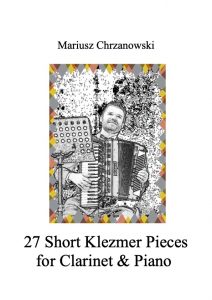 My ongoing search for living composers who write klezmer clarinet repertoire led me to Mariusz Chrzanowski. He was born in Poland in 1975, and is a multi-faceted musician: clarinetist, singer, accordionist, choral conductor, and wonderful composer of klezmer music, as well as other styles such as neo-classical, Irish, and Alpine.
My ongoing search for living composers who write klezmer clarinet repertoire led me to Mariusz Chrzanowski. He was born in Poland in 1975, and is a multi-faceted musician: clarinetist, singer, accordionist, choral conductor, and wonderful composer of klezmer music, as well as other styles such as neo-classical, Irish, and Alpine.
His Klezmer Suite for clarinet and piano is in three movements: “Fiddler,” “Dream of a Better Life,” and “Wedding Dance.” The first movement, “Fiddler,” is a little jewel that contains two sections: Ad lib and Tanz. “Fiddler” is intermediate level in difficulty, however it can be made more complex by adding klezmer effects and ornaments. Starting with the traditional doina, or slow improvisatory prayer (written out, with the choice to ad lib), it segues into a walking pace melody (tanz), accelerating in a freilach (happy song, indicated as mosso in the score), only to conclude much too soon. I would suggest repeating the mosso once or twice, giving the phrases a chance to accelerate and develop into an exciting, rapid, virtuosic, and joyous finale. This movement was initially composed for violin (2021) and works perfectly for clarinet. The second and third movements, “Dream of a Better Life” and “Wedding Dance” (2023), are both walking-pace dances with all the wonderful klezmer modes and harmonies. Recordings, some partial, are on YouTube.
27 Short Klezmer Pieces for clarinet and piano (2023) are indeed very short, easy/intermediate level compositions. Movements can be played in succession or hand-picked to form a short suite. Both parts include chords (transposed on the clarinet part) so various instrumentalists can provide their own version of accompaniment.
Klezmer clarinet music with composed piano parts is not easy to find, so this is a welcome series in this genre, which I anticipate becoming a delightful staple in our repertoire.
– Michele Gingras
Kelly Beaman. A True Hue of Blue. loveleighmusic.com, 2010. $10.00
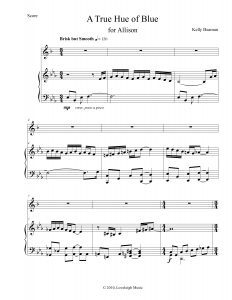 With A True Hue of Blue, Kelly Beaman has provided a light, entertaining, and upbeat single-movement work. Available with either piano accompaniment, as reviewed here, or fully scored for band, the eight-minute piece features a colorful clarinet line replete with unexpected harmonic and melodic twists. Repeated motifs and tones play prominent roles in the work, as do frequent changes in key, tempo, and meter. Syncopated materials also make important contributions to the catchy feel before the punctuated close.
With A True Hue of Blue, Kelly Beaman has provided a light, entertaining, and upbeat single-movement work. Available with either piano accompaniment, as reviewed here, or fully scored for band, the eight-minute piece features a colorful clarinet line replete with unexpected harmonic and melodic twists. Repeated motifs and tones play prominent roles in the work, as do frequent changes in key, tempo, and meter. Syncopated materials also make important contributions to the catchy feel before the punctuated close.
In terms of demands, the work is suitable for a moderately advanced player. It rarely features anything more complex rhythmically than 16th-note runs at quarter equals 120, and these runs are comprised primarily of comfortable steps and skips. Legato passages likewise dominate the melodic line, with few articulated segments. Yet, the clarinet part does sit fairly high on the instrument. Although the solo line briefly ventures down to low F, it generally remains above chalumeau B, and, at times, it soars all the way up to altissimo A.
On the page, both the clarinet part and the piano score are clear and easy to read. Moreover, the publication includes rehearsal letters as well as measure numbers at the beginning of each line, to aid in preparation. Page turns, however, could prove challenging if playing from a paper copy, which is available along with MIDI recordings from the composer’s website. In this case, the seven pages of clarinet music would likely need to be laid out over multiple stands. Similarly, the piano part would require a page turner.
Nevertheless, in spite of these minor inconveniences, the piece is well worth consideration. Indeed, it would provide a fun and energetic conclusion to a recital program.
– Lacey Golaszewski
Charles Louis Hanssens. Premier Concerto in E-flat Major and Deuxième Concerto in D Minor. Castejon Music Editions, 2013. Each €18.00
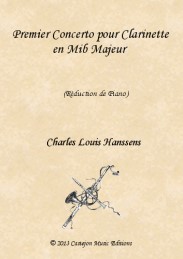 Most clarinetists have probably never heard the name of Charles Louis Hanssens (1802-1871), a Belgian cellist, conductor, and composer who came from a family of musicians. In fact, his father led the opera orchestra of Ghent, the city where he was born and his uncle was a composer and and conductor as well. He was an enfant prodige, becoming a member of the National Theater of Amsterdam at the tender age of 10.
Most clarinetists have probably never heard the name of Charles Louis Hanssens (1802-1871), a Belgian cellist, conductor, and composer who came from a family of musicians. In fact, his father led the opera orchestra of Ghent, the city where he was born and his uncle was a composer and and conductor as well. He was an enfant prodige, becoming a member of the National Theater of Amsterdam at the tender age of 10.
When he returned to Belgium he held the position of cellist at the Théâtre de la Monnaie in Brussels and then in Paris at the Salle Ventadour. As a composer Hanssens was self taught; and this is quite surprising! He did draw some inspiration from the works of Anton Reicha and, after winning a competition, was appointed professor of harmony at the Royal School of Music in Brussels. His output includes works of various genres, among them several string quartets, ten concertos, nine symphonies, operas, cantatas, oratorios masses, and a requiem.
The Premier Concerto, composed in Paris in 1836, had as dedicatee the belgian clarinetist F. Franck (1811–?), who was active in Brussels as a member of the Guides Regiment and then in Ghent (1840) as first clarinet of the Grand Theatre. The Deuxième Concerto, composed also in Paris, in 1837, had a different dedicatee, the great Belgian soloist Arnold Joseph Blaes (1814–1892). Both concertos have a similar formal structure with different movements but not separated from each other. Both are technically challenging, especially the first one which has, in my opinion, more interesting musical material. The writing is harmonically elaborate and was conceived in an advanced Romantic style in spite of the fact they were composed in the first decades of the 19th century. A fine recording by the well-known Belgian clarinetist Eddy Vanoosthuyse of both concertos is available on CD.
Hanssens also wrote a Gran Solo de Concert, a Fantaisie Concertante, and a Concertpiece for oboe and clarinet, also published by Castejon, and a Clarinet Concertino. We must be grateful to Mr. Castejon, Belgian clarinetist and owner of Castejon Music Editions for this first publication of the two newly discovered clarinet concertos. Nice material to be added to our clarinet concerto library!
– Luigi Magistrelli
Ulrich Kaiser. 12 Variations on “Happy Birthday to You,” for two melody instruments. Breitkopf & Härtel, 2017/2023. €14.90
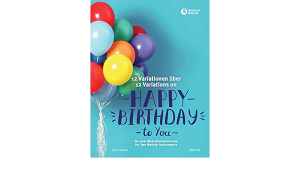 Dedicated to “all the birthday boys and girls around the world,” this charming, clever set of a theme and 12 variations should not be wasted on youth! For anyone young at heart, a smile on your face and a sense of delight will blossom when you either play this duet or are the listener recipient of the birthday wishes. The tune that everyone knows is treated to short variations each with a different style: hocket, aria, grazioso, sarabande, fugue, “reversal” (Umkehrung), fourths (Quartissimo), crab canon, humoresque, virtuoso, and two finales.
Dedicated to “all the birthday boys and girls around the world,” this charming, clever set of a theme and 12 variations should not be wasted on youth! For anyone young at heart, a smile on your face and a sense of delight will blossom when you either play this duet or are the listener recipient of the birthday wishes. The tune that everyone knows is treated to short variations each with a different style: hocket, aria, grazioso, sarabande, fugue, “reversal” (Umkehrung), fourths (Quartissimo), crab canon, humoresque, virtuoso, and two finales.
Mostly in G major or minor, this is a medium-difficult adventure, and the score, with both parts, runs nine pages—two clarinetists could play from the score in G. A clarinetist playing the top part will need good facility up to altissimo G. The music was originally conceived for flute and oboe; and to pair with them three additional versions of the lower part are included: one in treble clef for B-flat instruments, one in alto clef, and the third in bass clef for instruments in C. The number of possible pairings is therefore large.
– Gregory Barrett
Michael Drapkin. Drapkin’s Trios for the December Holidays, written and arranged by Michael Drapkin. Drapkin Music Publications, 2022. $45.00 www.bassclarinet.net
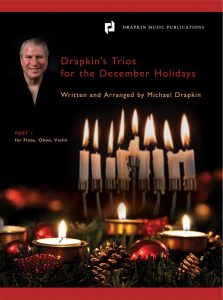 Michael Drapkin is at it again. The bass clarinetist with the excerpt books everyone should have on their shelves is putting pen to paper on another creative arranging project. Drapkin’s Trios for the December Holidays is a compendium of Christmas and Hanukkah classics for chamber ensemble. I have had the pleasure of performing many of Drapkin’s other arrangements. This collection is right up there with his best arranging work.
Michael Drapkin is at it again. The bass clarinetist with the excerpt books everyone should have on their shelves is putting pen to paper on another creative arranging project. Drapkin’s Trios for the December Holidays is a compendium of Christmas and Hanukkah classics for chamber ensemble. I have had the pleasure of performing many of Drapkin’s other arrangements. This collection is right up there with his best arranging work.
These trios are intelligently designed for great flexibility, but always keep the clarinet in the middle of the action. There are two overall sets for purchase of these tunes. Set One is arranged as follows: Part 1 is interchangeable between flute, oboe, or violin; Part 3 is flexible between bassoon and cello; and Part 2 is only for clarinet. Set Two is scored for two clarinets and bass clarinet. There are 54 tunes in this set, with all the big classics: Deck the Halls, O Holy Night, I Have a Little Dreidel, Hatikvah—as well as many others. Drapkin’s arrangement of The Twelve Days of Christmas is quite clever, and clarinetists who give it a shot will find it particularly funny!
This is the perfect set of gig music for events or just a fun reading session with friends or students. I have performed with a reed trio for many years, and these arrangements work beautifully for that combination. For those of us with string friends, they work just as well. There are three separate parts that are beautifully printed and clear—typical of Drapkin’s publications—with heavy bonded covers. Drapkin’s December Holidays is a fun and useful compendium of all the classics that will spice up the season.
– Osiris Molina
David Cook. 100 Chorales from the Music of J.S. Bach, transcribed for clarinet quartet by David Cook. Alea Publishing, 2023. Digital: $50.00, score only; Print: $50.00, score plus $10/each for additional auxiliary part.
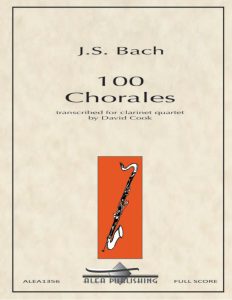 David Cook’s 100 Chorales from the Music of J.S. Bach is a wonderful addition to the clarinet ensemble repertoire. Each chorale starts as a quartet for three B-flat clarinets and bass clarinet. When playing as a quartet, performers are to play from the score. Additional performers can alternate or double the first part with E-flat clarinet, the third part on alto clarinet or basset horn, or extend the low range by having contra-alto and/or contrabass double or replace the bass clarinet part. Each auxiliary utilizes an individual part without score.
David Cook’s 100 Chorales from the Music of J.S. Bach is a wonderful addition to the clarinet ensemble repertoire. Each chorale starts as a quartet for three B-flat clarinets and bass clarinet. When playing as a quartet, performers are to play from the score. Additional performers can alternate or double the first part with E-flat clarinet, the third part on alto clarinet or basset horn, or extend the low range by having contra-alto and/or contrabass double or replace the bass clarinet part. Each auxiliary utilizes an individual part without score.
Bach’s music has been used by educators as a tool for years to teach harmony and counterpoint; this collection provides clarinetists the opportunity to apply those lessons with Bach’s music. Having quartets play from the score trains less experienced chamber players to perform as a cohesive unit. For more advanced players, the auxiliary parts add additional challenges. To facilitate the performers’ technical command of their instruments, the music selections present four chorales in each of the major and minor key signatures. The chorales also introduce instrumentalists to the sensitivity needed to perform with vocalists by including a verse or two of text.
The bottom line: this collection can fit any size clarinet ensemble, allow for growth, and facilitate improving technical and musical elements. This collection is a must-have for any clarinet studio, high school, college, or community group.
– David Deiter
Wolfgang Amadeus Mozart. Concerto in A Major for clarinet, string quartet, piano, and double bass ad. lib., KV 622. Arranged by Evgeni Orkin. Accolade Musikverlag, 2023. KA58823 €55.00
 Evgeni Orkin was born in Ukraine and is a clarinetist, composer, and teacher at the Mannheim Hochschule in Germany. His flexibility as a player allows him to perform and record with early clarinets or modern instruments in repertoire from various eras. In the last few years, he has been active on the early clarinet, making albums of classical and early romantic repertoire. His arrangements include Telemann Flute Fantasies for chalumeau, the Brahms Cello Sonata, op. 138, No. 1, and Schumann’s Album for the Young, op. 68, to be performed with clarinet and string quartet. The combination of piano and string quartet taking the role of accompaniment is used in his arrangements of Gershwin’s Rhapsody in Blue, Copland’s Clarinet Concerto, and here at hand, the well-known Mozart Clarinet Concerto. All the above cited works have been recorded by Orkin.
Evgeni Orkin was born in Ukraine and is a clarinetist, composer, and teacher at the Mannheim Hochschule in Germany. His flexibility as a player allows him to perform and record with early clarinets or modern instruments in repertoire from various eras. In the last few years, he has been active on the early clarinet, making albums of classical and early romantic repertoire. His arrangements include Telemann Flute Fantasies for chalumeau, the Brahms Cello Sonata, op. 138, No. 1, and Schumann’s Album for the Young, op. 68, to be performed with clarinet and string quartet. The combination of piano and string quartet taking the role of accompaniment is used in his arrangements of Gershwin’s Rhapsody in Blue, Copland’s Clarinet Concerto, and here at hand, the well-known Mozart Clarinet Concerto. All the above cited works have been recorded by Orkin.
Mozart Concerto arrangements with clarinet and string quartet have been made previously, but Orkin’s addition of piano is something new and welcome. As he personally explained to me, he thinks that during Mozart’s lifetime, and also later, it would be a common practice to use the cembalo (or piano) if some instruments were missing from the ensemble. The aim would be to fill the overall sound of the accompaniment when it was not possible to have a full orchestra, or the place was not big enough for so many players. The piano could also replace the winds and create a balance between clarinet and the strings. This arrangement is well conceived and realized. It is a nice solution for chamber music performances of this incredible masterpiece that our beloved Mozart offered us. Thank you Mr. Orkin and Accolade Musikverlag!
– Luigi Magistrelli
Nicole Buetti. Clarinet Masquerade Waltz. www.clarinetallmusic.com $25.00 score and clarinet choir parts.
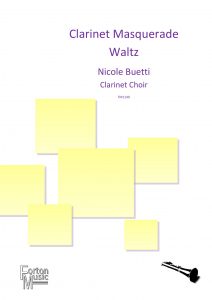 Nicole Buetti is an award-winning composer, educator, bassoonist, and contrabassoonist who performs with several orchestras in the Pacific Northwest. When she is not composing, puppeteering or performing, Buetti teaches bassoon at the University of Portland and has her own private teaching studio.
Nicole Buetti is an award-winning composer, educator, bassoonist, and contrabassoonist who performs with several orchestras in the Pacific Northwest. When she is not composing, puppeteering or performing, Buetti teaches bassoon at the University of Portland and has her own private teaching studio.
Buetti’s pieces are imaginative and engaging, with catchy themes and a variety of moods and evocative imagery. Her compositions run from deeply-felt, complex concert music to lighthearted and fun pieces. Somewhere in the middle of these poles are many of her wind compositions, such as the lovely Clarinet Masquerade Waltz.
The Clarinet Masquerade Waltz is a charismatic piece for a full clarinet choir, ranging from EÌ sopranino to contrabass. The idea for the piece was conceptualized by Barbara Heilmair and Nicole Buetti after they had a performance together of Buetti’s Midnight Waltz at Portland’s annual Vampire Ball. The idea of a haunting piece for clarinet choir sparked the commission of this work for the Zephyr Clarinet Choir who premiered the piece at the ClarinetFest® 2022 in Reno, Nevada.
With a spooky waltz theme, the composition features the unique sound of clarinets playing together. The composition has a feel of an elegant and festive dance turning wild. The latter is achieved by asymmetric rhythm patterns, drastic dynamic changes, and strong accents. Listeners can imagine a group of tipsy dancers being swept away by the intense music, trying to keep their balance. Or, one can simply enjoy the gorgeous sounds of low and high clarinets combined.
Like many of Nicole’s other works, the Clarinet Masquerade Waltz can also serve as an interesting tool for learners. It sparks excitement to listen and play… and maybe even to learn to play the clarinet! The piece is suitable for medium to advanced clarinet choirs. It will add a lighter note to concerts of advanced clarinet choirs, while it is accessible enough to provide an entry point for ensembles who are seeking to advance their musical skills via this piece. Players and listeners alike will find the Clarinet Masquerade Waltz to be a very valuable addition to the clarinet choir repertoire.
– Barbara Heilmair
Denis Betro. Tapestry for Clarinets. Forton Music, 2023. Digital: £10.50; Print: £14.00
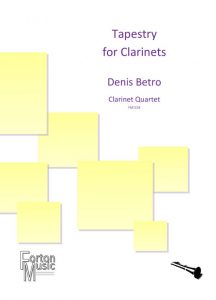 What a treat to have a clarinet quartet written by the electrifying composer Denis Betro! Betro originates from New Zealand and lives in the United Kingdom where he came to study music at the Royal College of Music. With his immense musical talent, Betro supported himself for years by playing music in the streets of London. He wrote several expressive pieces during his travels that started out as improvisation. An acclaimed composer today, his oeuvre touches with originality, expressivity, and invigorating atmosphere.
What a treat to have a clarinet quartet written by the electrifying composer Denis Betro! Betro originates from New Zealand and lives in the United Kingdom where he came to study music at the Royal College of Music. With his immense musical talent, Betro supported himself for years by playing music in the streets of London. He wrote several expressive pieces during his travels that started out as improvisation. An acclaimed composer today, his oeuvre touches with originality, expressivity, and invigorating atmosphere.
Denis Betro’s Tapestry for Clarinets is an upbeat, beautiful, and short work for a full clarinet quartet with E-flat, B-flat, and bass clarinets. The piece may first appear easier than it is because of its melodic and rhythmic material which hints towards minimalism in some places. However, this “simplicity” can be deceiving as there are accidentals, precise rhythms, and a careful ensemble balance to be mastered when playing it.
The quartet should work well for medium to advanced clarinet quartets, including in high schools and colleges. Its relative brevity would make it ideal to have students focus on the style and musical elements. While the quartet is not fully minimalist in style, it features combinations of small rhythmic and melodic cells that often reach across bar lines. Maintaining the mental focus on these motifs within the musical context can make an excellent preparation for playing fully minimalist music.
Denis Betro says in the introduction of his Tapestry for Clarinets, “The various contrapuntal lines in this piece weave in, out, and across each other in what I have termed a musical tapestry. A lot of unwinding and unfurling occurs which results in a satisfactory and homogeneous experience.”
This also addresses the delightful chamber music experience this quartet makes. In many places, there is a light polyphonic texture where all parts are equal, while in others there is a more homophonic setting in which two or more parts are trading tunes and the remaining parts have complementary roles. These roles are changing frequently and as a result, chamber music aficionados, students, and teachers will be immersed in listening to this web of melodies that is always active and lively.
To finish, a quote from Denis Betro’s website says it well: “Using a vivid rhythmic idiom and a tonal approach ensures that the music is accessible and enjoyable for a contemporary audience.”
– Barbara Heilmair
Samuel Barber. Adagio for Strings, op. 11. Arranged for clarinet choir by Eugene Andre Marquis. Grenadilla Records, 2023. $50.00 eclecticclarinets.com or Grenadilla Records, PO Box 19864, Cincinnati, Ohio 45219-0864
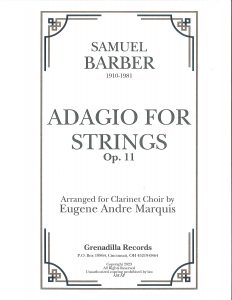 Cincinnati clarinetist Eugene Marquis offers a distinct alternative to Lucien Cailliet’s clarinet choir arrangement (1939/1964) of Barber’s Adagio for Strings. Where Cailliet’s arrangement sounds a whole step lower than the original tonality, Marquis retains the original, meaning that the melody in the first clarinet begins on C5, not throat-tone B-flat. Marquis’s version also differs from Cailliet’s in that no E-flat clarinet is required; the top note (C7) is in the first B-flat clarinet part. This points to another distinguishing feature of this arrangement: it adheres as closely as possible to Barber’s string ensemble version with only one type of instrument per melodic line. Marquis does not double a line with two different sizes of clarinets as Cailliet did.
Cincinnati clarinetist Eugene Marquis offers a distinct alternative to Lucien Cailliet’s clarinet choir arrangement (1939/1964) of Barber’s Adagio for Strings. Where Cailliet’s arrangement sounds a whole step lower than the original tonality, Marquis retains the original, meaning that the melody in the first clarinet begins on C5, not throat-tone B-flat. Marquis’s version also differs from Cailliet’s in that no E-flat clarinet is required; the top note (C7) is in the first B-flat clarinet part. This points to another distinguishing feature of this arrangement: it adheres as closely as possible to Barber’s string ensemble version with only one type of instrument per melodic line. Marquis does not double a line with two different sizes of clarinets as Cailliet did.
Marquis does offer variants in clarinets that can be used. Up to three E-flat sopranino clarinets could be used for the highest passage in place of B-flat clarinets. Either two basset horns or two E-flat alto clarinets are required, as are two bass clarinets (one to low C). The contra-alto clarinet part can ostensibly be covered by one of the bass clarinets. A contrabass clarinet is needed. The basset horn (or E-flat alto clarinet) and bass clarinet parts demand players adept at playing up to notated A-flat in the high altissimo.
Included with each order is a CD of Marquis’s single-performer multitrack recording that was reviewed by Madelyn Moore in the August 2022 “Audio Reviews.”
– Gregory Barrett
Comments are closed.